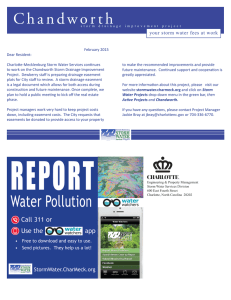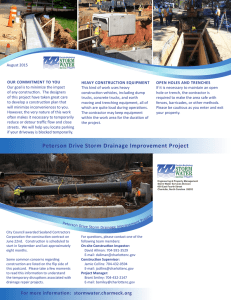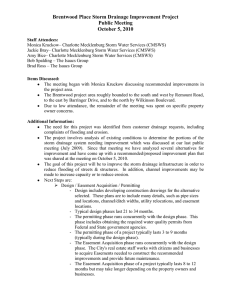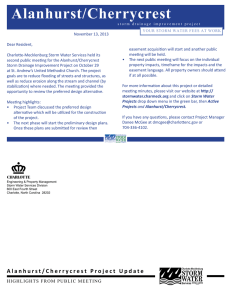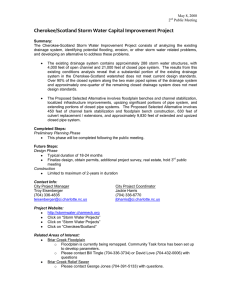US I MEETING MINUTES NFRASTRUCTURE OF CAROLINA, INC.
advertisement
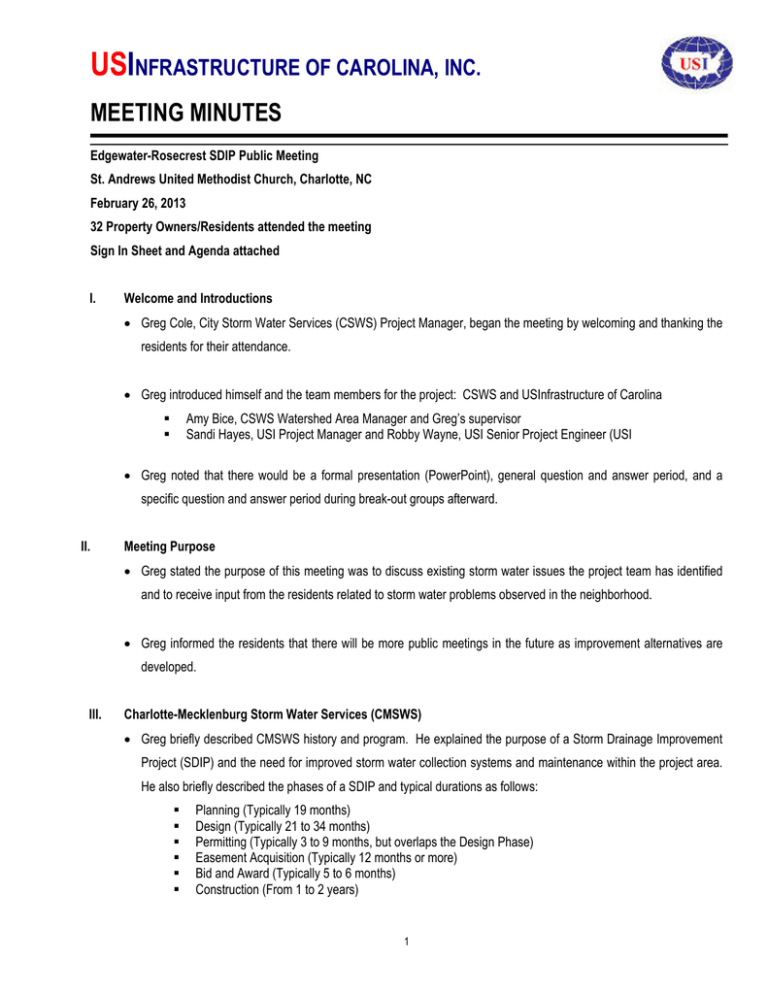
USINFRASTRUCTURE OF CAROLINA, INC. MEETING MINUTES Edgewater-Rosecrest SDIP Public Meeting St. Andrews United Methodist Church, Charlotte, NC February 26, 2013 32 Property Owners/Residents attended the meeting Sign In Sheet and Agenda attached I. Welcome and Introductions Greg Cole, City Storm Water Services (CSWS) Project Manager, began the meeting by welcoming and thanking the residents for their attendance. Greg introduced himself and the team members for the project: CSWS and USInfrastructure of Carolina Amy Bice, CSWS Watershed Area Manager and Greg’s supervisor Sandi Hayes, USI Project Manager and Robby Wayne, USI Senior Project Engineer (USI Greg noted that there would be a formal presentation (PowerPoint), general question and answer period, and a specific question and answer period during break-out groups afterward. II. Meeting Purpose Greg stated the purpose of this meeting was to discuss existing storm water issues the project team has identified and to receive input from the residents related to storm water problems observed in the neighborhood. Greg informed the residents that there will be more public meetings in the future as improvement alternatives are developed. III. Charlotte-Mecklenburg Storm Water Services (CMSWS) Greg briefly described CMSWS history and program. He explained the purpose of a Storm Drainage Improvement Project (SDIP) and the need for improved storm water collection systems and maintenance within the project area. He also briefly described the phases of a SDIP and typical durations as follows: Planning (Typically 19 months) Design (Typically 21 to 34 months) Permitting (Typically 3 to 9 months, but overlaps the Design Phase) Easement Acquisition (Typically 12 months or more) Bid and Award (Typically 5 to 6 months) Construction (From 1 to 2 years) 1 Greg explained citizen input in the form of questionnaires and 311 requests are important because the public input is highly valued and will contribute to the overall success of the project. Greg also noted the 311 requests and citizen questionnaire input received from the residents within the EdgewaterRosecrest SDIP area had contributed to a higher ranking for the project. Another factor to the ranking of the project was the drainage problems identified during the initial light rail work in 2003 to 2006. Greg stated the SDIP’s goals were to update the existing infrastructure, reduce the flooding in structures and streets, increase channel capacity, and reduce erosion. IV. Existing Conditions Analysis Results Note: Several copies of two large exhibits were provided for attendees to review and are attached for reference. 1. Exhibit - Existing Conditions Modeled versus Citizen Reported Drainage Issues: summarized the existing conditions analysis results and the citizen input reported to date. 2. Exhibit – 2010 Aerial Map: highlights the project drainage area and existing storm drainage systems Sandi Hayes informed the residents that the Edgewater-Rosecrest SDIP watershed is approximately 472 acres and contains over 40,000+ linear feet of drainage system. The project limits are generally bounded by Emerywood Drive to the north, Park South Station Boulevard to the east, Starbrook Drive to the south and Old Pineville Road to the west. Sandi continued by described the drainage conditions in the overall project area. Sandi stated that the neighborhood was built during the 1950’s and 1960’s, and the design standards at the time were much different than current standards. As a result, the analysis indicates the presence of undersized and outdated storm systems throughout the watershed. Pipe videoing, or televising, of some existing drainage systems was performed to determine the condition and verify system alignment. Sandi described, assisted by exhibits in PowerPoint, where the modeled results indicated areas where the system did not meet current City design standards (CDS) and indicate potential drainage concerns. Portions of the drainage system were not expected to meet current design standards because of the change in design criteria over the years. She noted the City’s storm drainage design standards have changed (increased) since the original neighborhood was built. Therefore, part of the analysis and evaluation focused on the performance of the existing system and identification of areas or locations were potential road and structural flooding may occur. The following were exhibits shown and explained during the presentation. 2 Potential Road Flooding o Culverts: 5 out of 7 culverts do not meet current CDS (Brookcrest, Candlewood, Edgewater, Wisteria, and Rosecrest) o Roadway Systems: 4 systems along South Boulevard (NCDOT maintained) due to undersized pipe systems 6 systems along residential roads throughout the neighborhood due to undersized pipe systems (Brookdale, Starcrest, Archdale, Ingleside, Londonderry, & Emerywood) Potential Structural Flooding: 22 total buildings have potential flooding concerns due to undersized drainage systems (8 finished floor flooding, 2 crawl space, and 9 HVAC or lowest adjacent grade). Channel Capacity & Instability Concerns: areas or segments with known stability and flooding issues Sandi noted that the next steps included receiving citizen input from the public meeting, developing improvement alternatives, selection of a recommended alternative, and presentation to the public at a second public meeting. The formal presentation was concluded after a general Question and Answer session. Specific questions were also answered by team members during the break-out session afterward. V. General Q & A Question: How did the City find out the watershed was in such poor condition? Response: As mentioned during the presentation, initial drainage analyses performed during the light rail work along South Boulevard helped identify issues and concerns within the area. This information, in combination with numerous citizen requests for service and reported problems, led to a high priority ranking of the watershed. Question: What type of channel improvements could occur for the project? Response: There are many options for stream improvements. Some areas require stabilization. Other stream improvements may involve increasing the capacity of the channel, changing the shape (typical section) or restoring natural habitat in and around the channel. The type of improvements for the channels with concerns has not been developed to date; however, the team will need to balance structural versus natural improvement options. Question: Are easements paid for? Response: The City will request donations for temporary and permanent easements for pipe and/or channel improvements. It was explained that compensation for an easement would be negotiated if necessary. It was also 3 explained that easement acquisition is not buying property, but simply to provide construction and/or maintenance rights to the City which will maintain the channel/pipe system indefinitely. Additional Response: Greg Cole explained that recent easement costs for channel improvements have doubled the cost of the improvements on recent projects. The City has had to remove some channel improvements from those projects for budget reasons and because the cost of easement acquisition along channels was expensive. If easements for channel improvements are not donated, some areas of improvement may be removed from this project. Question: Are channels public property? Response: No. Channels are owned by individual property owners. Channels are part of your property. Question: How can I give permission to do work without know what work will be done? Response: We are here to get public input tonight on problems in the area. We will not approach you for an easement until we have a design along your property with the improvements. Future public meetings will present the selected improvement alternative, conceptual alignments, and to get more public input and feedback. Once design is approximately 70% complete another public meeting will be held to begin easement acquisition. Question: Why did improvements at Archdale Road culvert encroach in my yard an additional 10’ further than the existing channel? Response: As part of channel improvements, certain slopes must be provided to achieve a sustainable growing area for vegetation. With the vertical side slope nature of the channels in this area, there is potential for channel improvements to encroach on properties. Question: Will there be any dry detention facilities associated with channel improvements? Response: There is potential to utilize storage within the channel and surrounding areas and possible dry detention ponds. If this is the case, permanent storm drainage easements would be acquired to utilize floodplain areas along channels or along the detention pond. Question: Will there be any hazardous material sites associated with the improvements? Response: No. The project area contains limited properties that may have hazardous materials on-site or stored above ground with appropriate permits (gas stations, industrial warehouses, etc.). The majority of the existing drainage system is not contained on these properties. We do not expect to encounter any hazardous material when constructing potential proposed improvements in the future. Question: How will construction gain access to areas needing channel improvements? What about maintenance of fences during construction? 4 Response: Access to construction areas along channels will be through temporary or permanent construction access easements. Part of the design is to determine the best access route for the areas of improvements. Some are temporary (through initial construction) and some are permanent so City crews have accessible routes to maintain channels and pipe systems in the future. All existing fencing will be reset or relocated to a permanent location. Temporary fencing may be installed during construction at specific locations. Question: How is the project funded? Response: This project is funded by the City Storm Water Program (Storm Water Fee). There are no anticipated budget issues to restrict or hinder funding of the project through the construction phase. A funding source has been identified for any alternatives that are selection for construction. This is a high priority project. Question: Will this project affect the FEMA floodplain or homeowners insurance requirements? Response: No. Question: Is this a precursor to a pedestrian path? Response: No, a pedestrian path through the neighborhood it is not part of this project. VI. Specific Q & A – Break-Out Groups Question (Candlewood Drive): A maintenance project was completed about 4 or 5 years ago and stripped my topsoil. I can’t grow grass. Also, small blowouts are developing along the top of the recently replaced system. What do I do? Response: Call in a 311 request and note this is a call back related to previous work. If blowouts are occurring again, there is potential that construction and stabilization of the system was not appropriate or adequate. We are currently analyzing this system for future improvements, but until your input, the modeled results concluded that this portion of the system was adequate to City standards. We will reinvestigate your claim as part of the future planning and resolve the issue as necessary. Question (Rosecrest Drive): How would improvements help our situation? Our backyard fence has fallen into the channel. We would like something done to resolve the 6’ to 8’ vertical drop from our backyard to the channel bottom. There also seems to be a lot of problems with existing utilities (water and sewer) and there are a lot of road repairs. Will improvements be coordinated? Also, there is currently a “sink hole” in the road and we assume it is related to the existing water lines. 5 Response: It is anticipated that channel improvements are likely to occur in the area. Potential improvements would lay the channel banks at approximately a 2:1 slope, which would encroach into your yard possibly 12’ to 20’. The team will coordinate with existing public and private utility agencies such that any planned improvements within the area can be considered for construction as one project. Comment (Edgewater Drive): The property owner stated they haven’t observed crawl space flooding but has experienced lowest adjacent grade. This property is within the FEMA floodplain. Comment (Rosecrest Drive): The property owner stated there are sink holes or blow outs forming along the pipe system in his yard between the road and the main channel. Comment (Highwood Place): The property owner stated there the lower level of the house has been flooded in the past. Comment (Highwood Place): The property owner stated there are blow outs over the existing pipe system in his yard. 6
